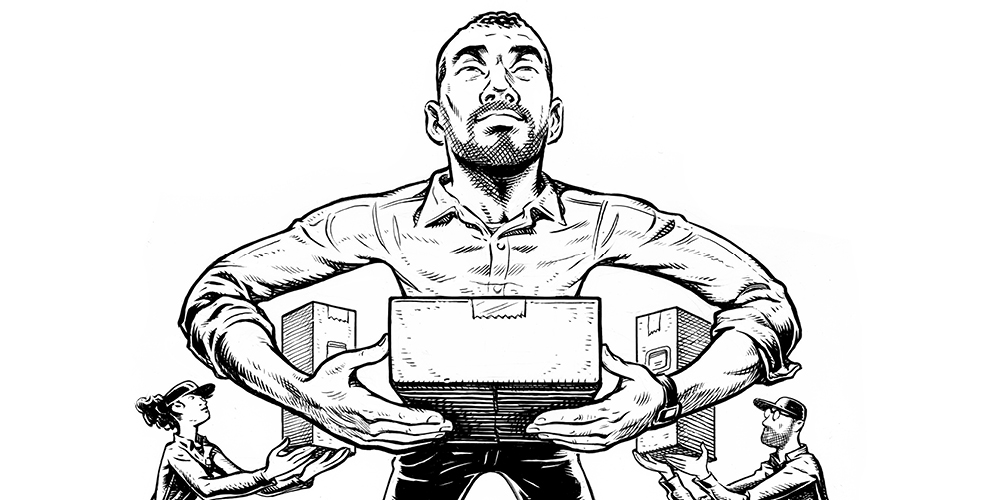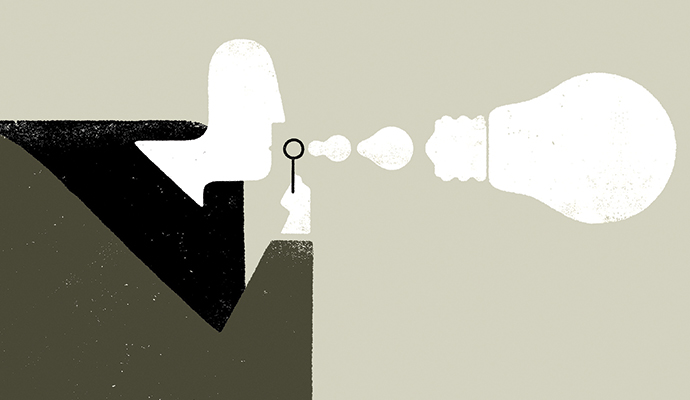How to deliver great customer experience at scale
The most effective customer strategies are grounded in active engagement, setting clear expectations and empowering users with options that suit their needs.
A version of this article appeared in the Spring 2021 issue of strategy+business.
As travel restrictions and lockdowns were announced around the world in the spring of 2020, businesses had to quickly rethink their customer experience strategy. Unable to continue in-person interactions, many companies looked for new ways to meet their customers (and identify new customers) online. Recent indications are that some of these trends will endure: Forrester predicts at least 80 percent of the B2B sales cycle will happen in digital settings moving forward. And according to eMarketer, “buy online, pick up in store” sales in the U.S. are expected to reach US$58.5 billion this year — a 60 percent increase over 2019.
For all companies, such shifts underscore the need to attract, retain, and build loyalty with customers. Yet in the 2020 Achieving Customer Amazement survey, U.S. companies across a variety of industries fell short of customer expectations by 38 percent, and 96 percent of customers said they would leave a company because of a bad customer experience. As a chief customer officer, I have found that such findings often reflect an approach that seeks to plug the hole before more water can escape. For example, many leaders have increased spending on digital capabilities and digital infrastructure. Although critical, these investments alone will not help create the scale companies need. Leaders are also investing heavily in customer support or other customer-facing teams, but this results in costs that increase linearly alongside business growth, impeding scale.
Instead, company leaders need to craft a long-term solution that will enable them to deliver great customer experience at scale, in ways that drive profitable growth. They should start by reexamining their underutilized assets and thinking creatively about how they define and sustain their customer relationships. Consider, for example, how a revived online community — led by motivated power users — could invigorate a customer base. Or how a well-articulated menu of options could make service expectations clear to both employees and customers. Or how a focus on lifetime value rather than short-term profits could improve retention. With a mix of old and new approaches, companies can compete in an experience-driven world.
▪ Engagement: Help customers help themselves. When it comes to customer experience, companies will often encourage teams to go above and beyond. Unfortunately, this approach can be uneven; customers have different experiences at different times or touch points. It can also overwhelm and overburden employees, creating fractures in customer-facing teams. When the inevitable issues occur, companies often throw money at the problem, expanding these teams to manage the overflow. This offers leaders a momentary sense of relief, but the issues are likely to reoccur.
Some problems simply don’t require an over-the-top response and in fact may be issues that customers can resolve without company support. To bolster self-sufficiency, companies need to help the customer learn about their product or service. For example, Starbucks has “trained” its customers over the years to use its own language and system when ordering beverages. When we walk into a Starbucks, most of us know to use “tall” in place of “small.” And customers are rewarded for their knowledge with experience: By learning and using the Starbucks language, they can place their order quickly, and the baristas are able to efficiently deliver custom beverages.
Of course, ordering coffee is different from troubleshooting a software issue or helping a customer understand how a new product feature can help improve his or her business outcomes. Even companies with complex products and services need a way to give customers information and support that encourages self-service. The good news is that most companies have channels developed for just this purpose. However, they may be judging the utility of such channels on metrics such as volume of interactions. But are they quality interactions? More important, are those interactions enhancing their customers’ knowledge of the company’s offerings?
If they take a closer look, leaders will often discover that they are not making the most of these channels. For example, companies often underleverage their online customer community. Many companies diligently put content on their website’s help center but may not take the time to integrate that content with an online community that operates in another silo. This is a missed opportunity, because an online customer community can help bring content alive by enabling “power users” — users who both feel that they have, and are considered by others to have, a voice of authority — to share their knowledge. And a well-integrated community enables the company to provide personal touches, for instance, by giving customers detailed product information or access to Q&As with product managers.
The challenge with online communities is that making the content available is easy, but finding the right incentives is hard. To promote regular use, companies should offer benefits or rewards, such as giving users social recognition (for example, “engagement badges” indicating their expertise that customers could add to their social media profiles) or giving them exclusive access to product managers for direct feedback.
Online music streaming service Spotify encourages its users to engage in its online community and to provide product ideas via its Idea Submissions page. Here, Spotify customers can submit suggestions on how they want the product to evolve, and other customers can vote on these ideas. Spotify then takes the critical step of closing the loop by letting its online community know which customer ideas have been implemented, which are under consideration, and so on. This engagement energizes power users, who will often provide answers to questions that other customers post or redirect them to the help center.
▪ Expectations: Promise and deliver. In marketing their products and services, companies frequently focus on how much they value and how well they treat their customers. This can lead to a vicious circle of increasing and then falling short of customer expectations. Dissatisfied customers may not return, or, worse, they may take their grievances to social media.
Clarifying expectations starts with aligning internal teams, including sales and support teams. Each team tends to interpret the top-line objective — delighting customers — differently. This may start at the earliest stage, when companies define their customer segments. At one company, it turned out that the billing team used the Fortune 500 list to determine critical customers, whereas the customer service team used revenue. This invariably led to customers being treated differently depending on the issue they were reaching out to the company about.
Companies also need to ensure people know what to expect once they sign on and become customers. One way that companies can set meaningful expectations is to provide a comprehensive menu of services. Many companies provide a list of product features, but what I am suggesting goes further, to also include the terms of the services that will be provided. This provides transparency for customers, and also for employees. More important, the menu establishes the minimum threshold for operating all customer-facing teams, enabling them to deliver a consistent experience. Additional guidelines can be constructed on top of the minimum service delivery expectations to empower team members to deliver additional support if needed.
These minimum thresholds can serve as important “floors” for ongoing investment in customer experience. By clearly outlining expectations for both features and customer experience, companies can invest the right level of resources and help internal teams deliver the right level of service. And when the company sets customer expectations reasonably and consistently, customers have a calibrated baseline for the experience they receive. In many cases, companies may choose to charge for premium-level services that come with faster issue resolution or increased availability — and this will be more palatable to customers when the company has been transparent about it from the outset.
By clearly outlining expectations for both features and customer experience, companies can invest the right level of resources and help internal teams deliver the right level of service.
Consider Atlassian, a software development and collaboration tools provider. The company starts with a typical menu of services, which is made up of product features, and then includes a comprehensive list of support options. But Atlassian also spells out the details, for example, noting specific hours when support is available and the initial response time when there is a service disruption. Customers can pay for higher levels of service and availability. And customers know when the company has gone above and beyond to solve a problem, for instance, if a representative responds to an issue over the weekend even though weekend support was not on the services list. Atlassian also offers service credits and is transparent about how to request these credits if the company fails to meet its stated service-level agreement for uptime.
▪ Empowerment: Maximize lifetime value. When companies think about providing value, the initial instinct may be to provide more bells and whistles. On the one hand, providing too many choices can be overwhelming for customers, especially when the customers are not able to connect these choices with their own success. On the other hand, companies may sometimes provide choices that make it easier for the company to deliver its products and services, but that are not optimized for customer needs.
To empower customers and give them the best options, companies have to deeply understand the customer journey and the customer’s business need or the problem that the company is attempting to solve. It is important to note that meeting customer needs is not only about offering the right product features but also about providing the right end-to-end experience, including services offered along the way.
For example, Peloton reports high retention rates; 93 percent of its members renew their subscription monthly. When a customer buys a Peloton bike, he or she receives a white-glove installation. In addition to performing the standard setup, the technician assists with the bike’s calibration and settings. The whole installation takes about 15 minutes. Peloton understands that the first-time experience matters in its customers’ journey and makes it easy for them to activate their membership and start exercising. And it aims to keep them exercising through features such as personal leaderboards that create peer-to-peer engagement and competition. (The company also considers the needs of those who want to exercise with their own equipment, offering a monthly subscription that can be used without owning a Peloton.)
In the case of business-centric products such as software or hardware, companies will also often try to bundle more product features so that customers are getting the biggest bang for their buck. If customers assume more is better, the company maximizes revenues from every sale. This may be a tempting approach given the continual pressure companies face to deliver on short-term revenue goals. In many cases, companies may pivot to subscription models to offer these product bundles and offset the cost of immediate ownership.
But this strategy can backfire: Customers may not buy because they may not want the additional product features, they may not think the additions justify the price, or they may have only sporadic need for the product. They may also be repelled by what they perceive as a bait-and-switch tactic. Many companies offer free services to source new customers and then convert them to paid members or subscribers. But this can ultimately create churn, as the customers end up paying for features they don’t use, canceling, and running to a competitor.
Canva, a graphic design platform that enables users to design professional content, provides a variety of choices to maximize its customers’ outcomes. The company understands that many customers may be timid about design software or may have tried other products only to feel frustrated or unsuccessful. Canva offers a free plan so that anyone can try out its platform. Some customers have greater needs and ultimately upgrade to a paid membership, but many users are satisfied with the core functionality of the free subscription. Still, the latter users may want to access other high-quality design assets such as stock photos, music, and videos. Rather than requiring these customers to purchase paid subscriptions, Canva allows users to buy virtual tokens that they can cash in for these assets as needed.
By engaging customers in ways that encourage them to help themselves and one another, by being clear about what they can expect from the company’s products and services, and by offering them options that will enable them to achieve their desired outcomes, leaders can respond to today’s challenges and position themselves for future success. Companies cannot simply invest in customer experience initiatives without showing results. The stock market and investors are rewarding profitable growth — and businesses will need to learn how to keep their customers first in a sustainable and scalable way.
Author profile:
- Dutta Satadip is the chief customer officer at ActiveCampaign. Previously, he built scalable customer experience organizations at Pinterest and Google.





